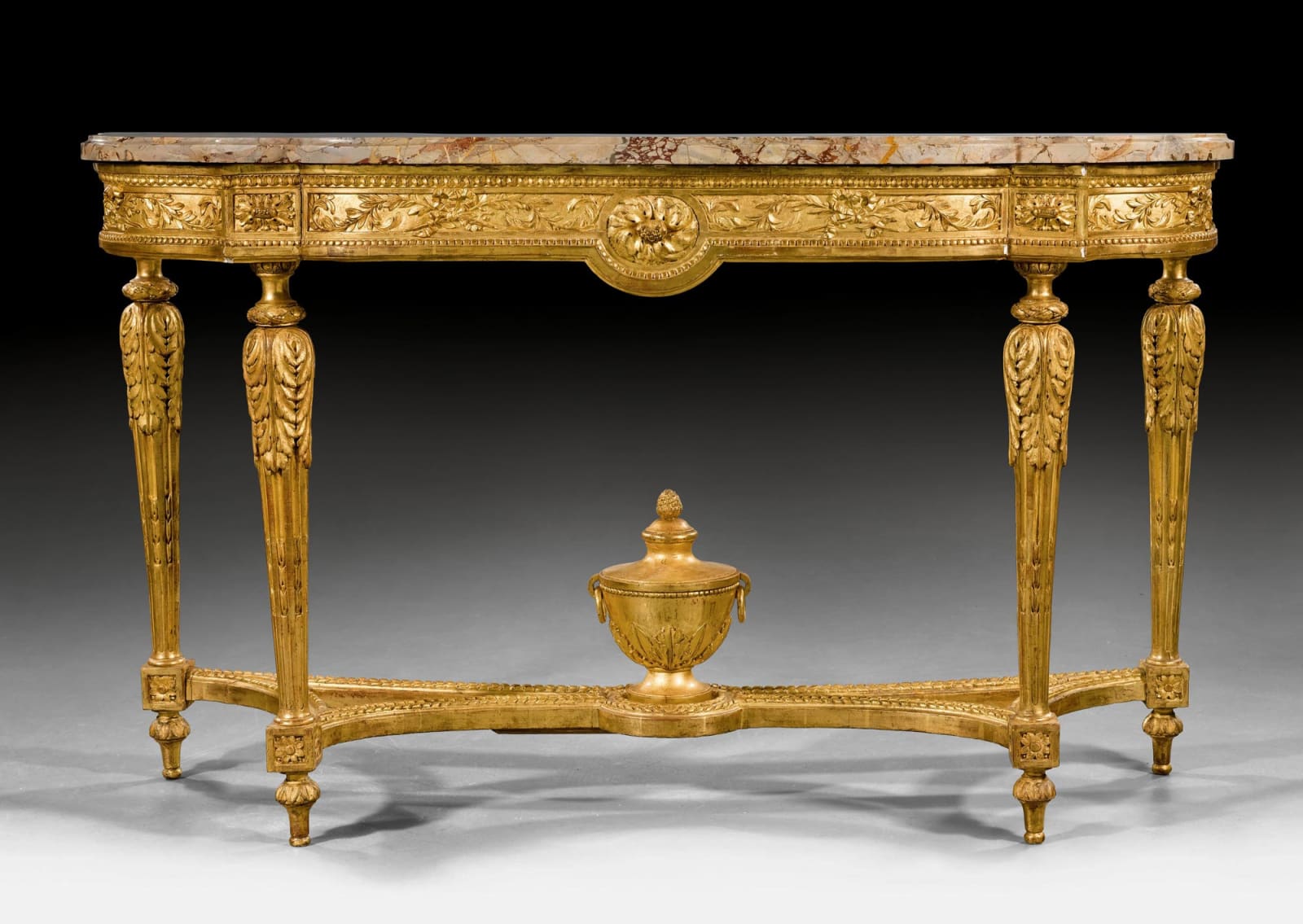Georges Jacob (attributed to) French, 1739-1814
An extremely fine Louis XVI giltwood console table attributed to Georges Jacob, the shaped demi-lune Brocatelle Violette marble top above a bead and foliate carved frieze filled with ribbon-tied foliate sprays flanking a central rosette within an oval frame and punctuated by further rosettes above four foliate-wrapped stop-fluted turned tapering legs joined by a concave-fronted x-shaped stretcher decorated with entrelacs centred by a two handled covered urn and supported on toupie feet
Paris, date circa 1785
Height 93 cm, length 148 cm, depth 48 cm.
This elegant and very finely carved console table is almost certainly the work of one of the leading menuisiers of the period Georges Jacob (1739-1814) who together with Jean-Baptiste-Claude Sené (1748-1803) dominated the production of carved furniture and menuiserie in Paris during the last years of the ancien régime. Their principal clients were Louis XVI and his wife Marie Antoinette for whom they provided an array of carved seats, stools, consoles, beds and screens for their residences at Fontainebleau, the Tuileries, Versailles and Saint-Cloud. Typical of Jacob’s work is the emphasis on expertly carved decoration that reflected the style of classical architecture and ornament as evidenced here in the stop-fluted foliate-wrapped legs and shaped stretcher surmounted by a Neo-classical urn. As such this console is closely related to a distinctive group delivered by Georges Jacob to Louis XVI’s brother Monsieur, the comte de Provence as listed in the inventory made on 17th October 1785, titled Mémoire des ouvrages faits pour le service du Garde-Meuble de Monsieur, frère du Roi sous les ordres de Monsieur de Bard par Jacob, Menuisier en meubles, rue Meslée, (as discussed in H. Lefuel, “Georges Jacob Ebéniste du XVIIIème Siècle” 1923, p. 200). The console also relates to a pair of white-painted and parcel gilt consoles attributed to either Jacob or Sené with rectangular tops and x-shaped stretchers from the Wildenstein collection (sold by Christie’s London, 14th December 2005, lot 72 for £254,500 inc. premium) which came from the Palais des Tuileries but may have been made for Saint-Cloud. The Wildenstein pair is identical to a further pair sold from the collection of the 5th Duke of Sutherland from Stafford House in 1913. Perhaps closer to the present console is another attributed to either Jacob or Sené that also came from the Palais des Tuileries (and later sold by Alfred Sussman at Galerie Georges Petit Paris, 18-19th May 1922, lot 129), which has a very similarly shaped stretcher as here, centred by a slightly different covered urn but with legs headed by Ionic capitals and having a slightly different demi-lune frieze. Further comparisons can be made with another console, featuring almost identical legs and bearing George Jacob’s stamp that was once in the collection of Anna Thomson Dodge (Christie’s London, 24th June 1971, lot 78).
Georges Jacob had an outstanding skill for creating carved furniture while his innovative genius enabled him to produce a wide variety of furniture designs. Such was his enduring repute that his work can be found among the world’s finest collections including the Wallace Collection and the Victoria and Albert Museum in London, Windsor Castle, the Musées du Louvre and des Arts Décoratifs in Paris, Châteaux de Versailles and Fontainebleau as well as the Musée Condé, Chantilly. The son of a peasant, Jacob was born at Cheny, near Tonnerre in Burgundy on 6th June 1739. Aged about sixteen he went to Paris where he served an apprenticeship under Louis Delanois before being received as a maître on 4th September 1765. Quickly establishing repute, from 1773 he received numerous commissions from the Crown. In 1781 he was appointed ébéniste-ordinaire to Monsieur, the comte de Provence (later King Louis XVIII); from 1784 he became one of the fournisseurs des menus-plains and was also among a small number of non-Germanic cabinet-makers to be favoured by Queen Marie Antoinette. Though best known for his chairs, he also made other types of furniture and was even involved in the restoration and replacement of the Boulle medal-cabinets at Château de Saint-Cloud. Jacob was also particularly interested in antiquity and shortly before the Revolution executed a suite of mahogany furniture in the austere classical style for the studio of the Neo-classical painter, Jacques Louis David (1748-1825).
